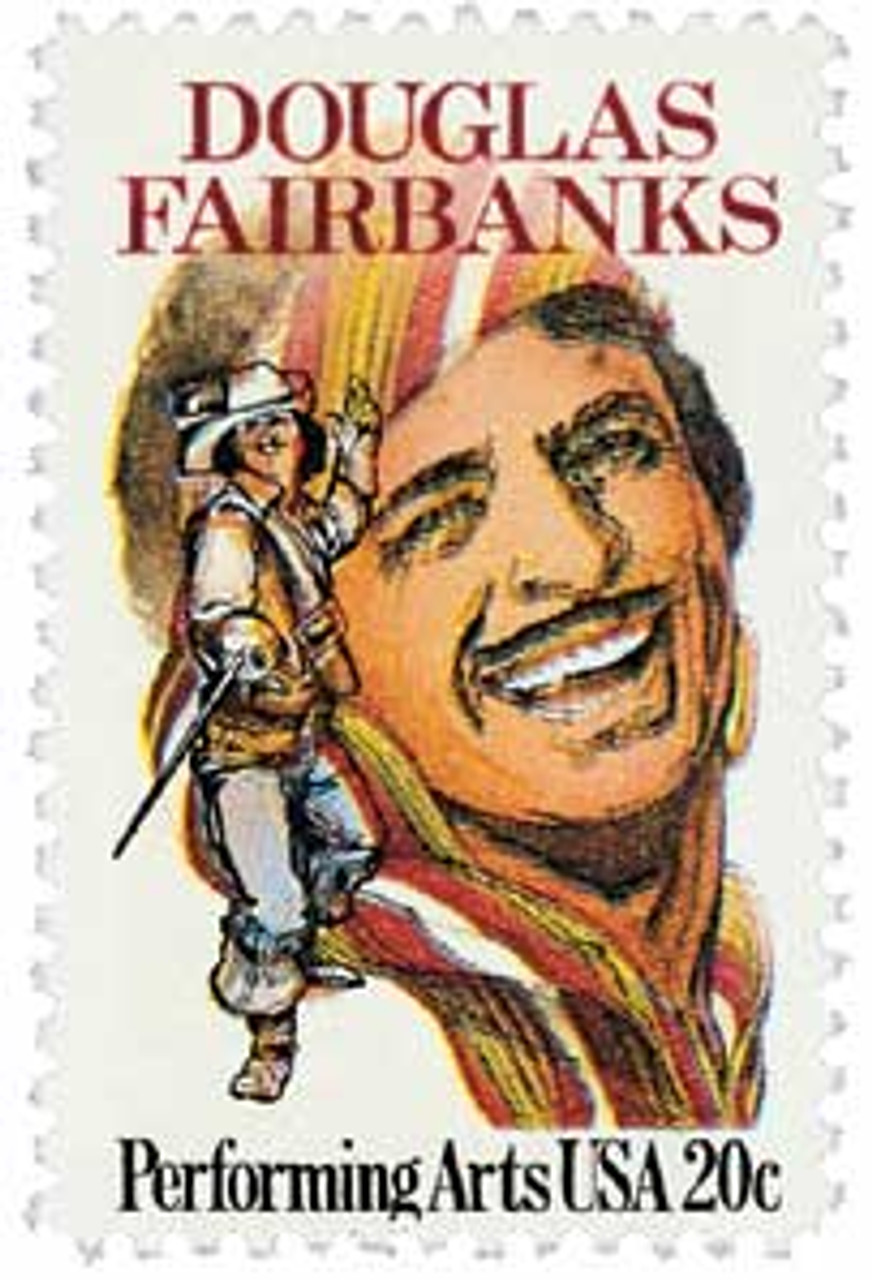
U.S. #2088
1984 20¢ Douglas Fairbanks
Performing Arts Series
- Issued on Douglas Fairbanks’s 101st birthday
- Considered the first stamp to successfully incorporate intaglio into a gravure design
- 6th Honoree in the Perform... more
U.S. #2088
1984 20¢ Douglas Fairbanks
Performing Arts Series
- Issued on Douglas Fairbanks’s 101st birthday
- Considered the first stamp to successfully incorporate intaglio into a gravure design
- 6th Honoree in the Performing Arts Series
Stamp Category: Commemorative
Series: Performing Arts
Value: 20¢, rate for first-class mail
First Day of Issue: May 23, 1984
First Day City: Denver, Colorado
Quantity Issued: 117,050,000
Printed by: Bureau of Engraving and Printing
Printing Method: Photogravure and Engraved
Format: Panes of 50 in sheets of 230
Perforations: 11
Why the stamp was issued: To mark Fairbanks’s 101st birthday
About the stamp design: The stamp features artwork by Jim Sharpe depicting Fairbanks in two famous roles. The large portrait depicts his character from the Thief of Baghdad, while the smaller figure shows his character from the Three Musketeers.
About the printing process: Since 1979, the Bureau of Engraving (BEP) and printing had been attempting to use it’s A Press to its full ability. The press had five gravure Andreotti units and a Giori intaglio section. Between then and 1984, the BEP experimented with stamps that incorporated both printing styles. Most of these featured designs that were largely printed by gravure with just the text printed by intaglio. The 1984 Douglas Fairbanks stamp was the first to incorporate the intaglio printing into the gravure design. The small inset image of Fairbanks holding a sword is outlined in intaglio and includes details printed in intaglio.
First Day City: The Fairbanks stamp was issued at the Denver Center for the Performing Arts, the actor’s hometown.
About the Performing Arts Series: The Performing Arts series ran from 1978 to 1987 and honored 12 performers of stage and screen including musicians and actors. Each stamp features a portrait of the performer. Several stamps include a second smaller image of the performer or other elements representative of their careers. Click here for the complete set.
History the stamp represents: Douglas Elton Thomas Ullman was born on May 23, 1883 in Denver, Colorado.
His father, Charles Ullman, served in the Civil War and founded the U.S. Law Association, which later became the American Bar Association. After he abandoned the family in 1888, Douglas’ mother reverted herself and her son’s last name to that of her first husband, Fairbanks.
Douglas Fairbanks discovered his love of acting at a young age. He began his career performing summer shows at the Elitch Gardens Theatre. Fairbank also worked with Margaret Fealy, who ran an acting school for Denver’s children.
After leaving school at the age of 15, Fairbanks joined Frederick Warde’s acting troupe. For two years he traveled the country acting and working as assistant stage manager. Fairbanks then left the group hoping to find success on Broadway. He had his first role there in Her Lord and Master in 1902. Fairbanks appeared in a number of Broadway plays in the coming years, including the popular A Gentleman From Mississippi. In between Broadway appearances, Fairbanks worked in a hardware store and as a clerk in a Wall Street office.
After marrying Anna Beth Sully and having a child (Douglas Fairbanks, Jr.) Fairbanks moved the family to Los Angeles where he signed a contract with Triangle Pictures in 1915. There he began a working relationship with D.W. Griffith and appeared in his first film, The Lamb, which showed off the athletic abilities that would later make him famous.
The following year Fairbanks created his own company, the Douglas Fairbanks Film Corporation, and soon began working with Paramount. That year he also met Mary Pickford (who he married in 1920). In 1917 Fairbanks, Pickford, and Charlie Chaplin traveled the country selling war bonds.
By this time, Fairbanks, Pickford, and Chaplin were the three highest-paid actors in Hollywood. To avoid being taken advantage of by the studios, the three of them and D.W. Griffith created United Artists in 1919, which granted them complete creative control over their films and the profits.
The following year, Fairbanks and Pickford were married. Known separately as “Everybody’s Hero” and “America’s Sweetheart,” they became one of the first celebrity couples and were dubbed “Hollywood Royalty.”
After just five years in Hollywood, Fairbanks had made 29 movies which were largely comedies displaying his athleticism. Wanting to branch out, Fairbanks proposed a type of costumed adventure film. The first of these films, The Mark of Zorro, premiered in 1920 and was a huge success. Fairbanks became a superstar and would produce many more swashbuckling films for the rest of his career. Some of the most famous were The Three Musketeers (1921), Robin Hood (1922), The Thief of Bagdad (1924), The Black Pirate (1926), and The Gaucho (1927).
Throughout the 1920s Fairbanks was at the top of his career. He, Pickford, and Chaplin established the Motion Picture Fund to aid people in the film industry that couldn’t pay their bills. He also took part in the first hand and foot print ceremony at Grauman’s Chinese Theater, was elected president of the Motion Picture Academy of Arts and Sciences, and hosted the first Academy Awards.
Fairbanks’ declining health and the introduction of “talkies” in the late 1920s and 30s brought about the decline of his career. Though he continued to act in talking films through 1934, he never achieved the same success he had with silent films. Fairbanks died on December 12, 1939, with his last words being, “I’ve never felt better.”








